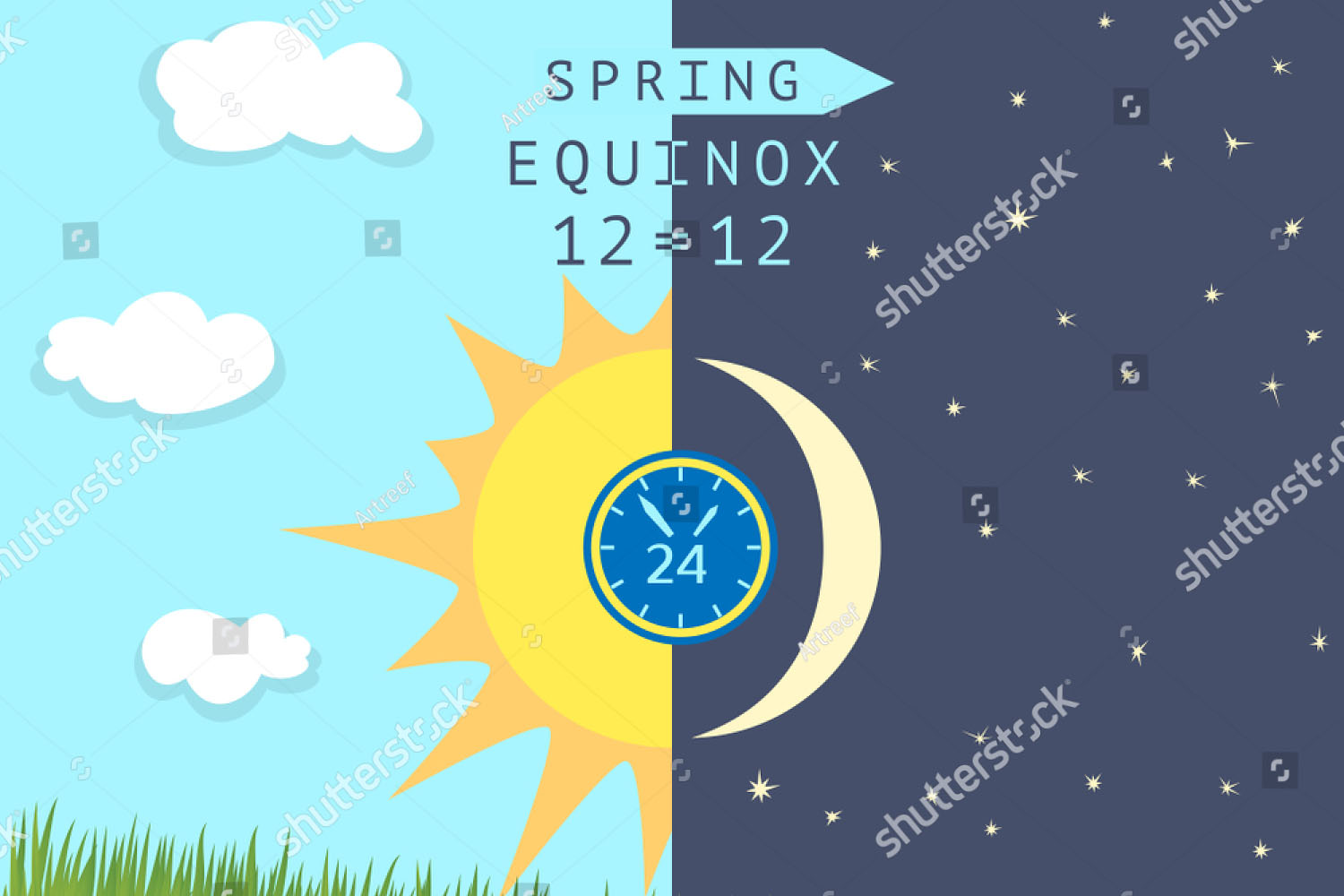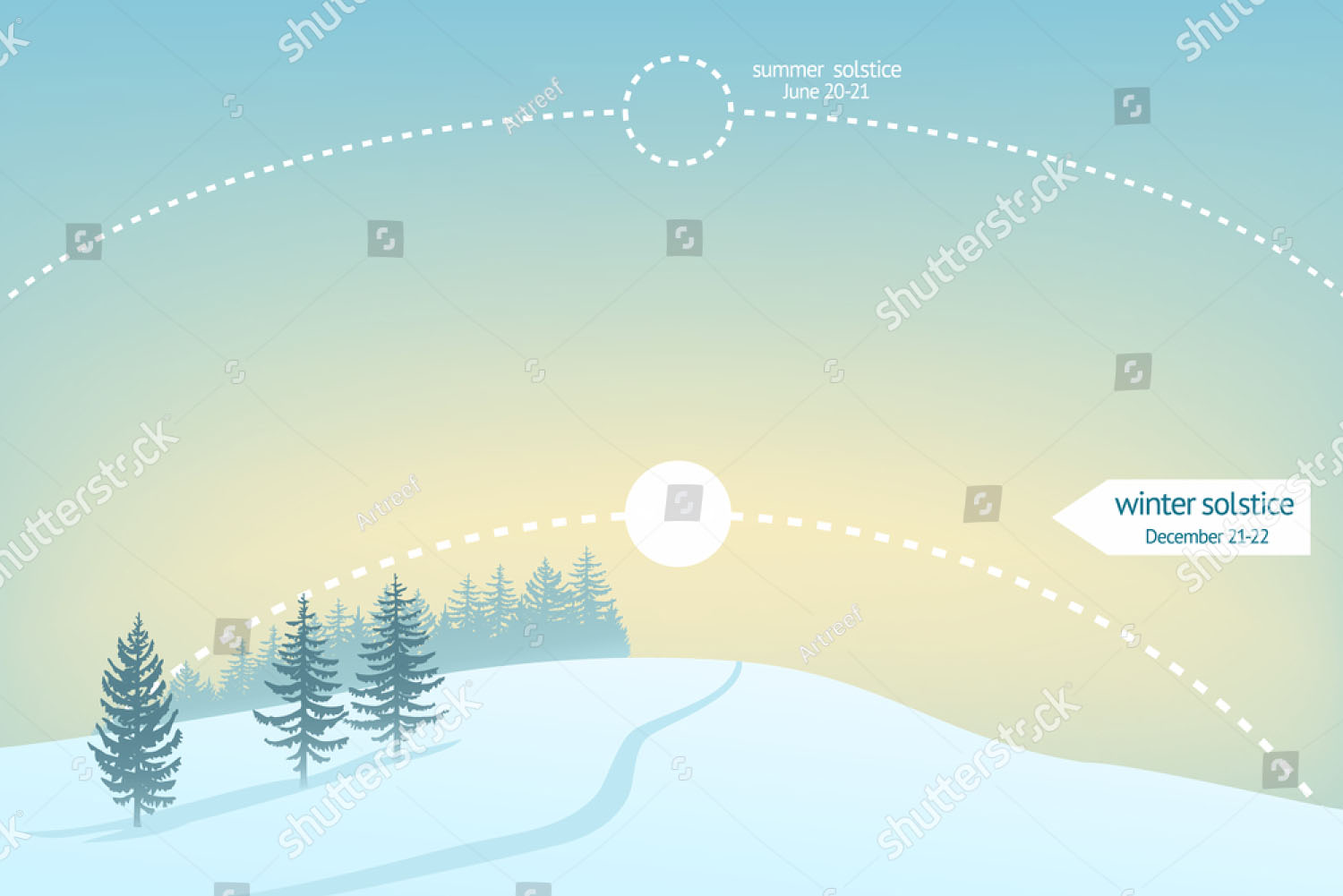The Equinox
There are only two times of the year when the Earth's axis is tilted neither toward nor away from the sun, resulting in a "nearly" equal amount of daylight and darkness at all latitudes. These events are referred to as Equinoxes.The word equinox is derived from two Latin words - aequus (equal) and nox (night). At the equator, the sun is directly overhead at noon on these two equinoxes. The "nearly" equal hours of day and night is due to refraction of sunlight or a bending of the light's rays that causes the sun to appear above the horizon when the actual position of the sun is below the horizon. Additionally, the days become a little longer at the higher latitudes (those at a distance from the equator) because it takes the sun longer to rise and set. Therefore, on the equinox and for several days before and after the equinox, the length of day will range from about 12 hours and six and one-half minutes at the equator, to 12 hours and 8 minutes at 30 degrees latitude, to 12 hours and 16 minutes at 60 degrees latitude.
The Solstice
The summer solstice occurs at the moment the earth's tilt toward from the sun is at a maximum. Therefore,
on the day of the summer solstice, the sun appears at its highest elevation with a noontime position that
changes very little for several days before and after the summer solstice. The summer solstice occurs when
the sun is directly over the Tropic of Cancer, which is located at 23.5° latitude North, and runs through
Mexico, the Bahamas, Egypt, Saudi Arabia, India, and southern China. For every place north of the Tropic of
Cancer, the sun is at its highest point in the sky and this is the longest day of the year.
The winter solstice marks the shortest day and longest night of the year. In the Northern Hemisphere, it
occurs when the sun is directly over the Tropic of Capricorn, which is located at 23.5° south of the equator
and runs through Australia, Chile, southern Brazil, and northern South Africa.
Solstice Celebrations
The term solstice can also be used in a wider sense, as the date (day) that such a passage happens. The solstices,
together with the equinoxes, are connected with the seasons. In some languages they are considered to start or separate
the seasons; in others they are considered to be centre points (in England, in the Northern Hemisphere, for example,
the period around the northern solstice is known as midsummer). Midsummer's Day, defined as St. Johns Day by the
Christian Church, is June 24, about three days after the solstice itself). Similarly December 25 is the start of
the Christmas celebration, and is the day the Sun begins to return to the Northern Hemisphere. The traditional
British and Irish (often) main rent and meeting days of the year: "the usual quarter days" was at first those of the
solstices and equinoxes.
Many cultures celebrate various combinations of the winter and summer solstices, the equinoxes, and the midpoints
between them, leading to various holidays arising around these events. During the southern or winter solstice, Christmas
is the most widespread contemporary holiday, while Yalda, Saturnalia, Karachun, Hanukkah, Kwanzaa, and Yule are also
celebrated around this time. In East Asian cultures, the Dongzhi Festival is celebrated on the winter solstice. For
the northern or summer solstice, Christian cultures celebrate the feast of St. John from June 23 to 24 (see St. John's
Eve, Ivan Kupala Day), while Modern pagans observe Midsummer, known as Litha among Wiccans. For the vernal (spring)
equinox, several springtime festivals are celebrated, such as the Persian Nowruz, the observance in Judaism of Passover,
the rites of Easter in most Christian churches, as well as the Wiccan Ostara. The autumnal equinox is associated with
the Jewish holiday of Sukkot and the Wiccan Mabon.
In the southern tip of South America, the Mapuche people celebrate We Tripantu (the New Year) a few days after the
northern solstice, on June 24. Further north, the Atacama people formerly celebrated this date with a noise festival,
to call the Sun back. Further east, the Aymara people celebrate their New Year on June 21. A celebration occurs at
sunrise, when the sun shines directly through the Gate of the Sun in Tiwanaku. Other Aymara New Year feasts occur
throughout Bolivia, including at the site of El Fuerte de Samaipata.
In the Hindu calendar, two sidereal solstices are named Makara Sankranti which marks the start of Uttarayana and Karka
Sankranti which marks the start of Dakshinayana. The former occurs around January 14 each year, while the latter occurs
around July 14 each year. These mark the movement of the Sun along a sidereally fixed zodiac (precession is ignored)
into Makara, the zodiacal sign which corresponds with Capricorn, and into Karka, the zodiacal sign which corresponds
with Cancer, respectively.
The Amundsen–Scott South Pole Station celebrates every year on June 21 a midwinter party, to celebrate that the Sun
is at its lowest point and coming back.
The Fremont Solstice Parade takes place every summer solstice in Fremont, Seattle, Washington in the United States.
The reconstructed Cahokia Woodhenge, a large timber circle located at the Mississippian culture Cahokia archaeological
site near Collinsville, Illinois, is the site of annual equinox and solstice sunrise observances. Out of respect for
Native American beliefs these events do not feature ceremonies or rituals of any kind.




